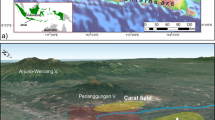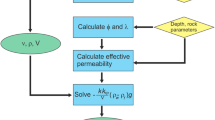Abstract
Oil and gas hydrocarbons are formed at temperatures above 100 °C by the chemical breakdown of the organic remains of dead organisms preserved in fine-grained rocks called source rocks. The organic remains are known as kerogen. If enough hydrocarbons are formed, some are expelled from the source rocks. We have analysed Kimmeridge Clay (Upper Jurassic) shales from the North Sea which are currently expelling hydrocarbons into adjacent sandstones. The results could be explained if most expulsion occurs by the pressure-driven flow of a discrete hydrocarbon phase through the pores of shales and into the pores of the sandstones, as suggested previously1. In addition, capillary forces seem to increase the efficiency of expulsion close to the interfaces between the shales and interbedded sandstones. It appears that molecular diffusion of hydrocarbons with less than about ten carbon atoms alters the composition of the hydrocarbon fluids remaining in, and expelled from, the shales.
This is a preview of subscription content, access via your institution
Access options
Subscribe to this journal
Receive 51 print issues and online access
$199.00 per year
only $3.90 per issue
Buy this article
- Purchase on Springer Link
- Instant access to full article PDF
Prices may be subject to local taxes which are calculated during checkout
Similar content being viewed by others
References
Tissot, B. P. & Welte, D. H. Petroleum Formation and Occurrence. (Springer, Berlin, 1978).
Harms, J. C., Talkenberg, P., Pickles, E. & Polock, R. E. in Petroleum Geology of the Continental Shelf of Northwest Europe (eds Illing, L. V. & Hobson, G. D.) 380–391 (Heyden, London, 1981).
Cooles, G. P., Mackenzie, A. S., Quigley, T. M. Org. Geochem. 10, 235–245 (1986).
Mackenzie, A. S., Price, I., Leythaeuser, D., Müller, P., Radke, M. & Schaefer, R. G. in Petroleum Geology of the Continental Shelf of Northwest Europe (ed. Glennie, K. W.) (Heyden, in the press).
Leythaeuser, D., Mackenzie, A. S., Schaefer, R. G. & Bjorøy, M. Bull. Am. Ass. Petrol Geol. 68, 196–219 (1984).
England, W. E., Mackenzie, A. S., Mann, D. M. & Quigley, T. M. J. geol. Soc. Lond. 144, 327–347 (1987).
Hinch, E. J. J. Phys. Chem. Hydrodynam. 6, 601–622 (1985).
Berner, F. C. & Bartell, F. E. Drill Prod. Pract. 341, 209–219 (1941).
Price, L. C., Wegner, L. M., Ging, T., Blout, G. W. Org. Geochem. 4, 201–221 (1981).
Radke, M., Sittardt, H. G. & Welte, D. H. Analyt. Chem. 50, 663–665 (1978).
Author information
Authors and Affiliations
Rights and permissions
About this article
Cite this article
Mackenzie, A., Leythaeuser, D., Muller, P. et al. The movement of hydrocarbons in shales. Nature 331, 63–65 (1988). https://doi.org/10.1038/331063a0
Received:
Accepted:
Issue Date:
DOI: https://doi.org/10.1038/331063a0
Comments
By submitting a comment you agree to abide by our Terms and Community Guidelines. If you find something abusive or that does not comply with our terms or guidelines please flag it as inappropriate.



